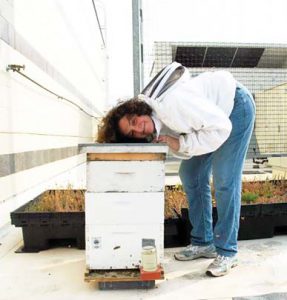Author: Alan Harman
 A South Pacific island saved by U.S. Marines in a 1943 battle that cost them 1,000 dead and 2,300 wounded is losing its fight to survive climate change.
A South Pacific island saved by U.S. Marines in a 1943 battle that cost them 1,000 dead and 2,300 wounded is losing its fight to survive climate change.
The 76 hours of what is called the toughest battle in Marine Corps history – the freeing of Tarawa, now named Kiribati – also saw 97% of the 4,800 Japanese defenders killed.
But today Kiribati. 1,840 miles southwest of Hawaii, is facing a new enemy as a rising ocean breaks through freshwater ponds, threatening communities and forcing some to be abandoned.
Two islets are underwater and some scientists and politicians say Kiribati, with its 100,000 population and maximum 6.5 ft. of elevation, will be the first country that will disappear because of global warming.
Prof. Simon Donner, a climate scientist at Canada’s University of British Columbia who has spent years studying the situation in Kiribati, tells Bee Culture the island country is “certainly” existentially threatened by sea-level rise.
“The mean sea level and Spring tides are clearly increasing, he says.
“The rising seas and higher tides are not necessarily just claiming land: they are reshaping the islands by changing when and how sand and other material is deposited and eroded.”
Donner says the islands may not “disappear,” as is usually reported in the media.
“But they will become prohibitively expensive to inhabit, as high tides damage homes and infrastructure, and saltwater infiltrates the local water supply.”
Climate scientist Ruth Lorenz of the Swiss Federal Institute of Technology in Zurich says climate change is increasing the number of days of extreme heat and decreasing the number of days of extreme cold in Europe faster than models project.
The number of Summer days with extreme heat has tripled since 1950 and the season has become hotter. The number of Winter days with extreme cold have decreased by at least half, while Winters have grown warmer.
As a result, beekeepers in Spain have moved more than one million Iberian black bees 3,940 ft. above sea level to protect them from rising temperatures.
The apiarists in Girona acted as climate change and extensive agriculture threatened the bees’ survival. The hives now are located beside tall trees, providing them with shade from the Spanish heat.
In Russia, The Moscow Times reports climate change may be playing a greater role in killing of the country’s honey bees than officials care to admit.
The newspaper says that from the Moscow suburbs to the Altai republic 2,500 miles to the east in Siberia, millions of bees were lost this past Summer.
Mass bee deaths were cited in 24 of Russia’s regions and 300,000 bee colonies died off during June and July – peak months for honey harvesting.
Along ocean coasts, climatologists say the waters are rising because the 5.4-million-square-mile Antarctic ice sheet containing 7.2 million cubic miles of ice, and the 656,000-square-mile Greenland ice sheet – as well as glaciers around the world – have been melting faster in the last 20 years than in the past 10,000.
Since 2003, Greenland has lost 281 billion tons of ice annually to melting, studies show.
Scientist say when water heats it expands, and about half of the rise in sea levels over the past 25 years is attributable to the water occupying more space.
Intergovernmental Panel on Climate Change (IPCC) researchers found that in 2014, global sea level was 2.6 ins. above the 1993 average and the average continues to rise at a rate of about an eighth of an inch a year.
Scientists predict that around the same time Kiribati becomes uninhabitable, southern Spain and other parts of Europe will become dangerously hot and dry.
As well, coastal cities around the world will flood, while wildfires in the Arctic will become normal.
Human flight or fight has already begun.
Indonesian President Joko Widodo, for example, recently announced a US$34-billion plan to build a new capital city in the east of Borneo island. Jakarta, the present capital, is in trouble after decades of depletion of groundwater reserves, rising sea-levels, and increasingly volatile weather patterns. These are combining to cause large areas of the city to disappear underwater.
And in Singapore, Prime Minister Lee Hsien Loong says it could cost more than US$100 billion over the next century to protect his island country from rising sea levels, hotter temperatures and more intense rainfall.
The IPCC declares in its latest report that keeping global warming to well below its 2ºC (3.5°F) target can be achieved only by reducing greenhouse gas emissions (GHG) from all sectors.
Panel Chairman Hoesung Lee says the report shows that better land management can contribute to tackling climate change, but is not the only solution.
Land must remain productive to maintain food security as the world population increases and the negative impacts of climate change on vegetation increase, the study finds.
This means there are limits to the contribution of land to addressing climate change, for instance through the cultivation of energy crops and afforestation. It also takes time for trees and soils to store carbon effectively.
Jim Skea, co-chairman of an IPCC report working group, agrees that land plays an important role in the climate system. “Agriculture, forestry and other types of land use account for 23% of human GHGs,” he says.
“At the same time, natural land processes absorb carbon dioxide equivalent to almost a third of CO2 emissions from fossil fuels and industry.”
Hans-Otto Pörtner, co-chairman of another IPCC working group, says the report shows land already in use could feed the world in a changing climate. “But early, far-reaching action across several areas is required.”
Kiyoto Tanabe, co-chairman of a task force on national GHG inventories, asserts that the choices taken on sustainable land management can help reduce and in some cases reverse the adverse impacts.
“In a future with more intensive rainfall the risk of soil erosion on croplands increases, and sustainable land management is a way to protect communities from the detrimental impacts of this soil erosion and landslides,” he says. “However, there are limits to what can be done, so in other cases degradation might be irreversible.”
The IPCC report finds climate change is affecting all four pillars of food security: availability (yield and production), access (prices and ability to obtain food), utilization (nutrition and cooking), and stability (disruptions to availability).
Report contributor Debra Roberts notes some dietary choices require more land and water, and cause more emissions of heat-trapping gases than others.
“Balanced diets featuring plant-based foods, such as coarse grains, legumes, fruits and vegetables, and animal-sourced food produced sustainably in low GHG systems, present major opportunities for adaptation to and limiting climate change,” she says.
IPCC report contributor Panmao Zhai says there are things already being done, including using technologies and good practices, but they need to be scaled up and applied in other areas.
Scientists say human use directly affects 69%-76% of the global ice-free land surface, which also plays an important role in the climate system.
Agriculture, forestry and other land use-activities accounted for about 13% of CO2, the IPCC report found. Some 44% of methane and 82% of nitrous oxide emissions from human activities globally during 2007-2016 represented 23% of total net human-caused emissions of GHG.
“Increasing impacts on land are projected under all future GHG emission scenarios,” the report warns. “Some regions will face higher risks, while some regions will face risks previously not anticipated.”
Response options throughout the food system, from production to consumption, including food loss and waste, can be deployed and scaled up to advance adaptation and mitigation.
All assessed modelled pathways that limit warming to 2.7ºF or well below 3.5°F require land-based mitigation.
“Policies that operate across the food system, including those that reduce food loss and waste and influence dietary choices, enable more sustainable land-use management, enhanced food security and low emissions trajectories,” the report says.
The adoption of sustainable land management and poverty eradication can be helped by improving access to markets, securing land tenure, factoring environmental costs into food, making payments for ecosystem services, and enhancing local and community collective action, the IPCC says.
Another food concern is how climate change is becoming a major threat to honey bees. Researchers say it is altering the scent of plants, and thus the capacity of bees to recognize them and orient themselves.
A bee remembers a fragrance and associates it with the resources provided by a given plant. Floral scent consists of hundreds of small molecules emitted by the plant. However, when a plant is stressed – due to a lack of water or because it has been attacked by herbivores – it responds by emitting defensive compounds that alter its scent.
Researchers also warn that warmer soil temperatures caused by climate change are expected to reduce soil moisture content in global ecosystems, resulting in higher crop productivity for wet regions but reduced productivity in dry regions.
Elsewhere, a new study debunks the theory that the burden of climate change will fall only on hot or poor nations.
Researchers from the UK’s University of Cambridge suggests virtually all countries will suffer economically by 2100 if the current trajectory of carbon emissions is maintained.
In fact, the research suggests that – on average – richer, colder countries would lose as much income to climate change as poorer nations.
For instance, under a business-as-usual emissions scenario, average global temperatures are projected to rise more than 7.2°F by the end of the century. This would cause the U.S. to lose 10.5% of its gross domestic product (GDP) by 2100.
Canada, which some claim will benefit economically from temperature increases, would lose more than 13%.
“Canada is warming up twice as fast as rest of the world,” study co-author Kamiar Mohaddes says. “There are risks to its physical infrastructure, coastal and northern communities, human health and wellness, ecosystems and fisheries – all of which has a cost.”
Mohaddes warns that 7% of global GDP is likely to vanish by the end of the century unless action is taken. Japan, India and New Zealand will lose 10%. Switzerland 12%, Russia 9% and the UK 4%.
Mohaddes says it isn’t just about the number on the thermometer, but the deviation of temperatures from their historical norms – the climate conditions to which countries are accustomed – that determines the size of income loss.
“Whether cold snaps or heat waves, droughts, floods or natural disasters, all deviations of climate conditions from their historical norms have adverse economic effects,” he says.
One-time Republican presidential candidate Marco Rubio, a U.S. senator from Florida, says his state will be forced to continue making adjustments.
“Trend lines suggest sunny day flooding will become increasingly common as local sea levels rise from a variety of causes,” he writes in USA Today. “As a result, some researchers predict that the 30-year mortgage will die out in low-lying parts of our state.”
Sunny day flooding – sometimes referred to as high tide flooding – is the term the National Oceanic and Atmospheric Administration (NOAA) uses to describe shoreline flooding that is not the result of a storm or some other weather event.
“Sea-level rise flooding is what it is,” says NOAA oceanographer Billy Sweet. “It’s front and center,” he asserts declaring this is not an end-of-the-century problem.
“If water is bubbling up through your streets, you’ve waited too long,” he warns.
Indeed, NOAA records show Boston suffered 19 days of flooding in 2018, a more than a 200% increase from 2000. Baltimore and Annapolis each broke records with 12 days and Cambridge totaled seven. Washington, D.C. saw a record 22 days of flooding.
From May 2019 to April 2020, NOAA’s predicts that high-tide flooding will occur about twice as often as it did in 2000. By 2030 and 2050, some locations could flood as many as 175 days a year.
Property values already are declining in the most-affected locations. Flooding rivers, meanwhile, which to date have caused damage estimated at more than US$100 billion a year, are set to get worse.
Vienna University of Technology flood expert Prof. Günter Blöschl, who led an international study involving 35 research groups, says the findings provide clear evidence that changes in the magnitude of flood events observed in recent decades can be attributed to climate change.
“Regardless of the necessary efforts of climate change mitigation, we will see the effects of these changes in the next decades,” he says. “Flood management must adapt to these new realities.”
Princeton University researchers make the same point. They predict coastal flooding for every county on the U.S. Eastern and Gulf Coasts. They also warn 100-year floods could become annual occurrences in New England and happen every one-to-30 years along the southeast Atlantic and Gulf of Mexico shorelines.
A 100-year flood now has a 1% chance of happening every year.
“The historical 100-year floods may change to one-year floods in northern coastal towns in the U.S.,” said Ning Lin, associate professor of civil and environmental engineering.
But Robert Kopp, director of the Rutgers University Institute of Earth, Ocean and Atmospheric Sciences, says trying to accommodate flooding with things such as infrastructure hardening, berms, flood proofing, building elevation, creating spaces that can be inundated, even floating cities, are all short-term solutions.
“If the average tide is higher, you will get more flooding,” Kopp says. “At some point high-tide flooding will turn into permanent flooding. Then it’s a matter of do you want to live with your house elevated above the water permanently?”
Economics Prof. Todd Pugatch of Oregon State University says in a study this year that tropical-storm-related deaths increase under most climate change scenarios by as much as 52%
Rubio says Americans, particularly Floridians, are right to be concerned about the changing climate.
“But they are also right to be concerned about a regressive overreaction,” he declares. “Plans stemming from panic will constrain our economy and cripple our ability to invest future resources in solving longer-term issues.”
Rubio says instead of restricting options for the next generations by borrowing against their future, “we should choose adaptive solutions deliberatively, buy time and maximize the choices available to them in the decades and centuries to come.”
But scientists insist time is not on their side.
NOAA says that since the late 1800s, human-caused climate change has warmed the Earth’s average temperature by about 1.8° F. While extreme heat may not trigger the same visceral fear as a tornado, it causes nearly twice as many fatalities in the U.S. each year – more than any other weather hazard.
Indeed, a study by Tom Matthews, of the UK’s Loughborough University, reveals that once the wet-bulb temperature – where the air factoring in cooling as a result of evaporation – reaches 95°F, the body can no longer cool itself through evaporation of sweat, which can lead to heat stroke and death.
Extreme heat was rare 50 years ago in the U.S., but research by climate scientist James Hansen, former director of NASA’s Goddard Institute for Space Studies, shows extreme Summer heat now occurs about 7% of the time.
U.S. record highs have been outpacing record lows at a ratio of two to one, his study maintains. This difference could grow to 20:1 by mid-century and 50:1 by the end of the century.
In Europe, a heatwave in 2003 was estimated to have caused 70,000 deaths, and researchers found human influence at least doubled the risk of an event of that magnitude.
In 2010, another 56,000 people died in a heatwave in Russia, and researchers declare there is an 80% probability the excessive temperatures would not have occurred without global warming.
Most recently, the 2019 Summer saw two intense heatwaves in Europe just weeks apart and shattering records. Both were linked to human-caused climate change.
Modelling indicates the number of heatwave days may increase by four to 34 days a season for every 1.8°F of global warming. Some tropical regions could experience up to 120 extra heat-wave days a season if the Earth warms by 9°F, which could happen by 2100.
Equally as disconcerting, a recent study released by the Union of Concerned Scientists finds Dallas, Texas, predicts a few days above 105°F each year, but by 2050 this is expected to reach almost 30 days – and 60 or more by 2100.
University of Würzburg studies show higher mean temperatures can also have a severe impact on plants and animals by disrupting their relationship.
Beleaguered bees, for example, already under pressure from habitat loss and intensive agriculture, will see their delicate alliance with flowers suffer as the timing of plant flowering and bee hatching must coincide.
The pasque flower (Pulsatilla vulgaris), as one example, is extremely sensitive to rising temperatures, flowering earlier each year, whereas one of its major pollinators, a solitary bee species, can’t keep pace by hatching earlier, reports researcher Sandra Kehrberger.
This may cause the plant’s seed production to decrease and impair reproduction while requiring the bee to switch to other plants for its food supply, she says.
Another consequence of rising temperatures is forest fires that now rage Summer and Winter throughout the continents, from North and South America to Australia.
In Australia, the Seasonal Bushfire Outlook warns that the east coast of Queensland, New South Wales, Victoria and Tasmania, as well as parts of southern Western Australia and South Australia, face above normal fire potential.
It has been the fifth-driest start to the year on record, data shows, and the driest since 1970. The south experienced the driest January to July ever.
In Canada, boreal forests that have acted as carbon sinks for millennia are becoming sources of atmospheric carbon, potentially contributing to the greenhouse effect.
Prof. Merritt Turetsky of the University of Guelph, found a combustion of legacy carbon in nearly half of the samples taken from young forests less than 60 years old. This carbon escaped burning during the previous fire cycle but not during the record-setting 2014 fire season.
Yale University, meanwhile, reports climate change is also ratcheting environmental health threats including disease-carrying bugs expanding their range.
“Climate change is impacting our communities, in our backyards, right now,” it quotes Amir Sapkota, a professor at the Maryland Institute for Applied Environmental Health, as saying.
More than 70 major U.S. medical groups released a call to action this year declaring climate change a public health emergency.
“It’s so important that people recognize that climate change is about our health,” says Jonathan Patz, director of the Global Health Institute at the University of Wisconsin.
Pathways include heat, air pollution, extreme weather, vector-borne diseases, and access to safe water and food. Heat stroke and exhaustion are some of the heat-related illnesses that can include cardiovascular and kidney problems.
Without reductions in GHG emissions and atmospheric concentrations, climate change is also expected to make air quality worse.
“From your respiratory health such as asthma, to cardiovascular diseases, to mortality, you name it, air pollution affects so many different things,” Sapkota says.
Disease-carrying insects such as mosquitoes and ticks are expected to expand their range and activity, according to a Canadian National Microbiology Laboratory report that says warmer Winters are likely to increase the number of ticks that survive and lengthen their active season.
Climate change is also expected to negatively affect crop yields with floods, droughts and storms wiping out agricultural fields. Warmer Summer temperatures may make growing some crops such as corn, more difficult. Elevated levels of carbon dioxide could reduce the nutritional value of wheat and rice.
European researchers say increased warming is also promoting the invasion of the honey bee pest, the small hive beetle (SHB).
The study by Wageningen University in Netherlands, the University of Bern, Switzerland and the Center for Environmental Research, Germany, found that under the current climate, the results show many areas globally not yet invaded by SHB are suitable for the pest, suggesting a considerable invasion risk.
“Future scenarios project a vehement increase in climatic suitability for SHB and corresponding potential for invasion,” the study says. This is especially true in the temperate regions of the northern hemisphere, the researchers say in the study published in Global Change Biology.
“This is a clear case for global warming promoting biological invasion of a pest species with severe potential to harm important pollinator species globally,” the report says.








